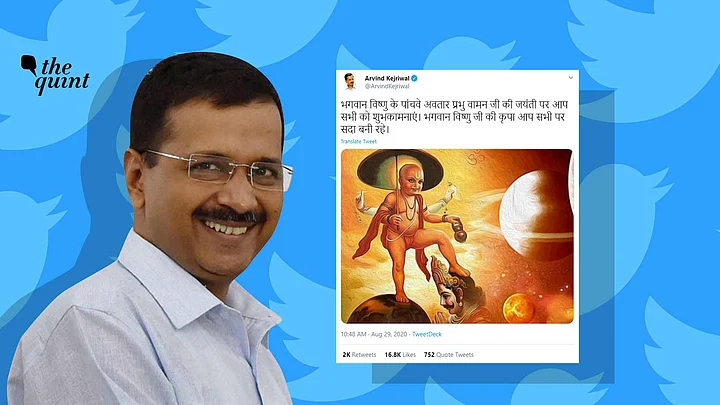Delhi Chief Minister Arvind Kejriwal found himself at the receiving end of jokes and memes from an unlikely source - Malayali Twitter users. At the root of this trolling lies a tweet posted by Kejriwal from his official Twitter handle on Saturday 29 August, wishing people on “Vamana Jayanti”.
The image used by Kejriwal in his tweet showed Vamana, an incarnation of Lord Vishnu, placing his foot over ‘asur’ King Mahabali.
Now, King Mahabali is a loved figure for the people of Kerala and his reign is said to have represented prosperity and equality.
The legend goes that Mahabali’s popularity evoked the envy of deities as well and this prompted Lord Vishnu to approach Mahabali as Vamana, a Brahmin boy. Vamana is said to have tricked Mahabali into giving away his kingdom and go into the netherworld. But Mahabali was allowed to visit his people annually and Onam is celebrated to welcome him.
Therefore wishing people on Vamana Jayanti and showing Vamana’s “triumph” over Mahabali was seen as an insult by many Malayalis.
#HappyOnamKejriwal Trends
Though Kejriwal did wish Malayalis on Onam, the damage was done with the Vamana Jayanti tweet. Several twitter users from Kerala tweeted with the hashtag #HappyOnamKejriwal to poke fun at the Delhi chief minister.
Some non-Malayalees also joined in.
Some, such as Delhi Congress leader Shivani Chopra, also pointed out that in 2016, the then BJP president Amit Shah had put out a similar tweet wishing people on Vamana Jayanti.
However, Kejriwal won some praise from prominent pro-Hindutva handles.
Why is Vamana Jayanti Important?
While the discourse surrounding Vamana may not be positive in Kerala, that is not the case in many parts of North India where Vamana Jayanti is important for the Brahmin community. Not just Kejriwal, several politicians in Hindi speaking states across party lines, extended wishes on the festival.
These include Uttar Pradesh chief minister Yogi Adityanath, BJP national general secretary Kailash Vijayvargiya and Congress leader from Haryana Kuldeep Bishnoi.
The reason is clear - the need to woo Brahmins.
- Brahmins aren’t just a votebank, they also control the media, intellectual sphere and administration across much of India.
- Then there is the fact that Brahmin Mahasabhas are extremely well organised and push the community’s support in an extremely strategic manner in every election.
- While BJP has been the overwhelming choice of Brahmins in Lok Sabha polls for the past three decades, community representatives have made tactical deals with other parties at the state level.
- Therefore, it becomes important for parties, especially in the Hindi heartland, to appease the community even if it is through token measures like wishing on Vamana Jayanti.
What’s AAP’s Calculation?
A Upper Caste-Dominated, Centre Right Party
- The Vamana Jayanti tweet is only one part of a larger process that the AAP is carrying out - its deliberate attempt to occupy the Centre Right space.
- This Centre-Right approach is evident by the fact that AAP has been relatively soft as far as criticising BJP on communalism is concerned, but far more outspoken on issues like Chinese incursions. This strategy was also clear when AAP accused BJP of masterminding the Shaheen Bagh protests.
- Though AAP claims that it doesn’t follow the politics of caste and religion, it is essentially an Upper Caste Hindu dominated party.
- The Upper Caste domination can be seen from the fact that eight out of nine members of AAP’s political affairs committee listed in the party website are Upper Caste Hindus. This is AAP’s highest decision making body.
- The national executive is marginally more representative with 14 out of 22 being Upper Caste Hindus.
- It appears that the AAP’s main expansion mission is to become an alternative to BJP voters who may not be comfortable voting for the Congress for whatever reasons.
Kerala and Tamil Nadu Not a Priority
- It is clear that Kerala doesn’t feature in AAP’s radar. This is not surprising. Even the BJP is finding it difficult to make serious inroads in Kerala, which is dominated by the Congress-led UDF and the Left, so there is even little space for a neophyte party like AAP.
- Also in Delhi, Malayali voters are minuscule in number and aren’t decisive factor in more than one or two constituencies.
- Even in Tamil Nadu, AAP doesn’t seem to have any expansion plans. It has given tacit backing to actor-turned-politician Kamal Haasan, another Upper Caste politician promising “clean governance”, much like Kejriwal.
(At The Quint, we question everything. Play an active role in shaping our journalism by becoming a member today.)
